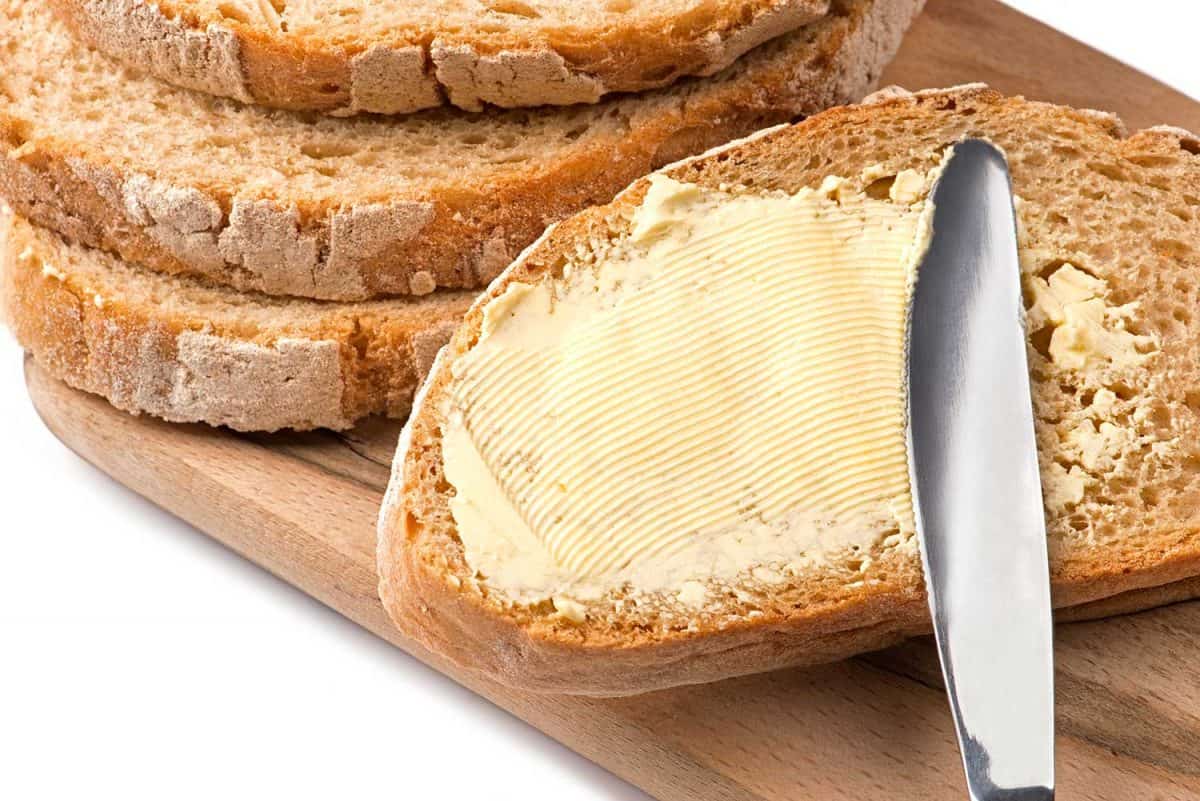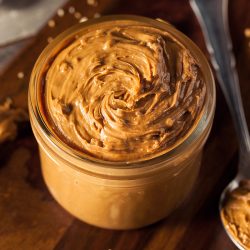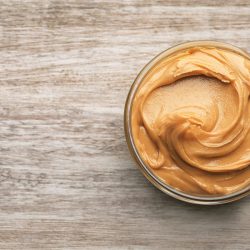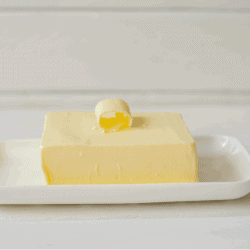Butter is a dairy product that seems to defy the laws of food safety. Butter is often stored and served at room temperature, and you may even have a friend or family member that insists on leaving butter on the kitchen counter at all times to keep it creamy and spreadable. But is butter actually safe to eat unrefrigerated? Won't it go bad or get moldy? For this article, we conducted some research, and we will discuss the safe ways to store butter and answer your questions related to mold growth in detail.
Due to its high fat and low water content, butter has a longer shelf-life than most dairy products, but butter can get moldy. Once mold starts growing visibly, we suggest throwing it out. Mold roots and spores also grow throughout butter and are not always easy to spot or remove. In addition, butter usually goes rancid before mold starts to grow, spoiling the quality and taste.
Although we recommend using a fresh product for optimal taste, if you are running low on your butter supply and need to salvage what you have to finish a recipe, you are in luck. Moldy or rancid butter is not entirely inedible. We encourage you to continue reading as we explore the methods to safely remove mold from butter and how to properly store butter to maximize its shelf-life and prevent spoilage and mold. We will also help you identify when butter is safe to eat and how to prolong its shelf-life and maintain freshness.
![A natural organic butter for breakfast, Does Butter Get Moldy? [And What To Do If That Happens]](https://kitchenseer.com/wp-content/uploads/2021/04/Does-Butter-Get-Moldy-667x1000.png)
Can You Eat Butter With Mold On It?

If you happen to eat butter with mold on it, don't worry. Eating moldy butter is not life-threatening, nor will it give you food poisoning or even make you sick. However, once the quality starts to deteriorate and butter goes rancid, the smell and taste become off-putting and may change the flavor of or even spoil your favorite recipe. Fresh is always best.
Safely Removing Mold From Butter
If you don't want your moldy butter to go to waste, one option to safely remove mold is by freezing. Before freezing your butter, cut out any visible mold spots. The freezing process will kill any remaining mold spores that may be hidden. Once frozen solid, the butter can be thawed out and eaten again safely.
Why Does Butter Go Moldy?
Oxidation is a natural process that causes food to deteriorate over time when exposed to oxygen and ultimately is what causes butter to go moldy. Oxidation cannot be prevented, but choosing the right storage method will help slow down the process.
Light and Air Exposure
Exposure to light and air are the primary factors that contribute to mold growth on butter. Storing butter in an opaque, air-tight container helps reduce exposure to these elements, slowing down the oxidation process.
Heat Exposure
Exposure to extreme heat also promotes mold growth in butter. If storing butter at room temperature, keep your container away from the oven and other heat sources and ensure the average temperature in your kitchen does not regularly exceed 70°F. In hotter temperatures, you may want to opt to keep your butter refrigerated.
Contaminates
Crumbs and other food particles may sometimes transfer to your butter when using unclean utensils to spread butter on food such as toast. These food contaminants are typically more susceptible to mold and can escalate mold growth in butter. It is best to keep utensils clean and avoid cross-contamination to prevent mold.

Should Butter Be Refrigerated?
The composition of butter naturally inhibits bacterial growth and butter does not need to be refrigerated. However, storing butter in the refrigerator will significantly prolong its shelf-life over storing at room temperature. When refrigerated, butter typically stays fresh for up to a month. You can also follow the best buy date on the packaging, which tends to be conservative.
Freezing Butter
If you have a large quantity of butter, freezing is another option that will keep your butter fresh for longer. Butter can last up to six to nine months in the freezer. When ready to eat, just thaw in the refrigerator or at room temperature. A tip when freezing butter is to wrap the sticks in aluminum foil and place them in a plastic freezer bag. The additional layers of protection will help prevent the butter from taking on the flavors of other foods in the freezer and avoid freezer burn.
How Do You Store Butter At Room Temperature?
Storing butter at room temperature is perfectly safe and keeps your butter soft and creamy, making it easier to spread on your favorite foods. Based on the United States Department of Agriculture (USDA) recommendation, you should only store the amount of butter you intend to eat within one to two days at room temperature and keep the rest refrigerated. The flavor may start to turn rancid if left out for several days.
Salted Vs. Unsalted Butter
Butter comes in both salted and unsalted varieties. Salt acts as a natural preservative and when storing butter at room temperature, salted butter will retain its freshness for longer than unsalted, typically one to two weeks.
Choosing Your Storage Container
Finding the right storage container for your butter is key to preserving its freshness when storing at room temperature. A butter dish is perfect for storing butter at room temperature for a short period of time and reduces exposure to elements. Butter dishes come in many designs that will surely compliment any dish pattern and dinner table décor. Butter dishes also make great gifts. For more gift ideas, check out our article, "33 Kitchen Gift Ideas for Moms Who Love To Cook."
Click here to see the Sweese Porcelain Butter Dish at Amazon.
Another common container used to store butter at room temperature is a butter crock, also known as a butter bell or French butter keeper. A butter crock contains an inner pot that holds the butter. The inner pot is immersed in water, creating an air-tight seal. Due to the significant reduction in exposure to elements, butter can be stored safely at room temperature for up to 30 days in a butter crock.
Click here to see The Original Butter Bell Crock at Amazon.
These two container types are specifically designed with butter in mind to extend its shelf-life, but any air-tight container will help maintain freshness. If you are on a budget, use a plastic food container instead. If you want to learn some interesting tricks to keep plastic food containers air-tight, check out our article, "How To Seal Plastic Food Containers."
How Do You Know If Butter Has Gone Bad?
Now that you have a better understanding of how to properly store butter and prevent mold and spoilage, let's discuss other ways, in addition to mold, to determine when butter has gone bad and should be thrown away.
- Smell - One of the key indicators that butter has gone bad is the smell. Rancid butter will develop a sour smell, similar to blue cheese.
- Taste - In addition to a sour smell, rancid butter also develops a sour taste.
- Appearance - Fresh butter is an even, yellow color throughout. Once butter goes bad, you may also notice a change in its appearance. Look for discoloration and change in texture.
To Conclude
Hopefully, you now know all your options when it comes to moldy butter and how to prevent it. If you are interested in other ways to keep food fresh, please check out our following articles:
Does Rice Go Bad In The Pantry?
How To Make A Cookie Jar Airtight
Do Glass Containers Keep Food Fresh Longer?





![A glass jar with creamy peanut butter on wooden table, Can Peanut Butter Go Bad In Heat? [Yes! Here's How To Tell If It's Spoiled!]](https://kitchenseer.com/wp-content/uploads/2022/10/Glass-jar-with-creamy-peanut-butter-on-wooden-table-250x250.jpg)


